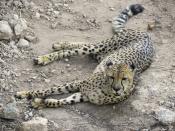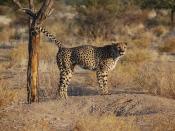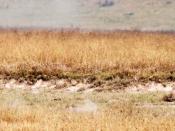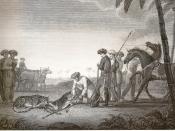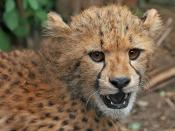Stalking through the tall, sun burnt grass of the plains a predator is stalking the unsuspecting wildlife. That predator is the agile cheetah. This essay will be giving you as much information on the big cat as it can. It will tell you about its amazing running ability and hunting habits. Also, it will explain how it socializes and breeds. Then it will brush on it past as well as comment on his endangered present and how we can make it so that it does not have an endangered future.
This essay will start off by giving you some general information on the cheetah. The scientific name of the cheetah is Acinonyx Jubatus (http://dialspace.dial.pipex.com/ 7-5-01). The name cheetah comes from the word for "Spotted one"ÃÂ in Hindi (Amann 38). The life span of the cheetah is 12-14 years (http://dialspace.dial.pipex.com/7-5-01). Another fact you should know is that they are an endangered species on the brink of extinction (www.cheetahspot.com
7-5-01).
This essay is now going to describe the appearance of the cheetah for you. The cheetah's is most recognized by its tan fur and black spots. This pattern allows him to camouflage well in the tall grass so he can stalk his prey. The cheetah weighs about 45-65 kg and is about 1100 mm "ÃÂ 1600 mm long (http://dialspace.dial.pipex.com/ / 7-5-01). Male and female cheetahs look about the same, but the male is a little bit larger than the female (www.cheetahspot.com 7-5-01).
Cheetahs live in the grasslands, steppes and plains Africa. The habitat of a cheetah is usually an open and grassy environment (www.cheetahspot.com 7-5-01). They need the open area for running after their prey. The cheetah is known to have had a large population in the Middle East, but this was many years ago. The oldest fossil of the cheetah was found in Texas, USA, and is dated as 4 million years old (www.cheetahspot.com 7-5-01).
One of the reasons the cheetah is so famous is because of its amazing speed. The cheetah is known to be the worlds fastest land animal. It can travel at 70 miles per hour for up to 300 yards (www.cheetahspot.com 7-5-01). The cheetah has paw pads and un-retractable claws that it uses for traction when it is running. It has a large liver, heart and lung and that helps him run faster (www.cheetahspot.com 7-5-01).
The cheetah lives as a predator, which makes it a carnivore. That means it hunts other animal for its food. It uses sight, not smell, to find food because it has extremely good eyesight. First, the cheetah stalks its prey, and then when it is at the right distance it runs after the animal in a swift chase (www.cheetahspot.com 7-5-01). This chase will go on for up to 3.4 miles, but the cheetah will not start it unless the animal runs. The cheetah does all of its hunting and chasing in the day, unlike most wild cats who hunt at night (www.cheetahspot.com 7-5-01).
The cheetah has a more or less solitary lifestyle. A male will usually live in a group of two of three with other males and these groups will hunt for life. The female cheetahs, on the other hand, live alone for most of their life unless they have a litter of cubs with them (www.cheetahspot.com 7-5-01). The area that a group of male cheetahs will roam is about 37.4 km squared. These areas are usually about 300 miles from the male's parents. Females live in areas of about 835 km squared. Instead of living away from the home of their parents like the males, cheetah females take over the home of their mothers (www.cheetahspot.com 7-5-01).
Cheetah females are the one of the parents who takes care of the litter. A male and female cheetah will only meet to mate with each other and then the male cheetah leaves (www.cheetahspot.com 7-5-01). The cheetah litter is made of only about 3 to 5 cheetah cubs. These cubs are born blind and toothless (www.pbs.org 7-5-01). Most of the cubs in the cheetah litter do not make it to adulthood. The cheetah cubs have a death rate of about 75 percent. The cubs that do live stay with their mothers for 18 months until they are able to hunt on their own and take care for themselves (http://dialspace.dial.pipex.com/ 7-5-01).
As this essay has already stated, the cheetah is an endangered species. In fact the Asian cheetah is all but gone off the face of the earth. It now can only be found in Iraq and Afghanistan. The reason for all of the dropping number of cheetahs is the spread of men and the increase of hunting (www.cheetahspot.com 7-5-01). The fur of a cheetah has for years been a sign of wealth and this one of the reasons for the hunting of the animal. Because of this there are now only about 15,000 cheetahs in the world today (www.cheetahspot.com 7-5-01).
There is good news though; people are now trying to find ways to save the endangered cheetah. There are now reserves being made throughout Sub-Saharan Africa for the cheetahs to live and grow in numbers on (www.pbs.org 7-5-01). Also, people are now putting the cheetah in zoos and captivity in order to breed them so that we will always have the cheetah with us. Most cheetah lovers, like myself, would believe that it will help the fight to protect the cheetah if we where to make stricter laws on hunting and stronger punishments for poaching (www.pbs.org 7-5-01).
In my opinion, which I am making from the information on this paper, the cheetah is one of the most extraordinary animals on the planet. The cheetah is not a very social animal; it usually lives alone or in small groups (www.cheetahspot.com 7-5-01). The cheetah hunts and uses its amazing speed to chase its prey. When the litter is born, the mother is the one to take care of the litter, only meeting with the male of the species to mate (www.cheetahspot.com 7-5-01). After doing the research of the cheetah, I have decided that it is more than an interesting animal; it is something precious that we should try to protect at all costs.
